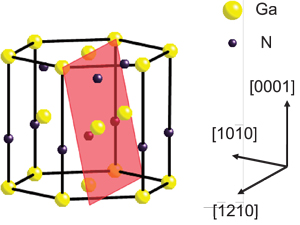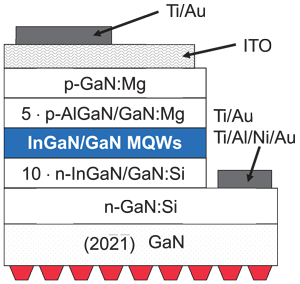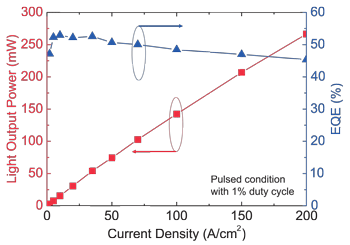- News
20 July 2011
Reducing LED droop at high current with nitride semiconductors
University of California Santa Barbara (UCSB) and Japan’s Mitsubishi Chemical Corp have produced blue-violet light-emitting diodes (LEDs) with high output power and low droop by using (20-2-1) indium gallium nitride (InGaN) structures “for the first time” [Yuji Zhao et al, Appl. Phys. Express, vol4, p082104, 2011].
The reduced droop of the device up to injection current of 200A/cm2 is described as “outstanding” (Table 1), being only 14.3% at the upper limit. “To the best of the authors’ knowledge, such a low droop has not been reported at current densities of 200A/cm2,” the team comments.
Current density (A/cm2) |
35 |
50 |
100 |
200 |
EQE (%) |
52.6 |
50.7 |
48.4 |
45.3 |
Droop (%) |
0.7 |
4.3 |
8.5 |
14.3 |
Table 1: EQE and droop performance of semi-polar blue-violet (20-2-1) LED at various current densities.
The researchers are working to improve the performance of LEDs for general lighting. This requires more cost-efficient devices with higher output power. Unfortunately, nitride-based LEDs have a tendency to be less efficient at higher injection currents/output power – a phenomenon often referred to as ‘droop’.
 Although UCSB’s own theoretical team under professor Chris Van de Walle blames an indirect Auger recombination process for droop (UCSB theory blames indirect Auger recombination for nitride LED droop), other research groups continue to dispute this.
Although UCSB’s own theoretical team under professor Chris Van de Walle blames an indirect Auger recombination process for droop (UCSB theory blames indirect Auger recombination for nitride LED droop), other research groups continue to dispute this.
Figure 1: Schematic view of semi-polar (20-2-1) plane in the wurtzite crystal structure.
One approach that might ameliorate the droop effect is to use nitride semiconductors oriented in semi-/non-polar directions, rather than the usual c-plane crystals that have strong polarization fields. These polarization effects lead to electric fields in the active region of the device, which tend to separate the electrons and holes that researchers want to recombine as light emission.
The semi-polar (20-21) orientation has recently been investigated for producing longer-wavelength green-emitting devices, including lasers. The UCSB devices use the opposite orientation of (20-2-1) (Figure 1). Mitsubishi Chemical supplied the free-standing (20-2-1) GaN substrates on which the epitaxial structures (Figure 2) were grown using metal-organic chemical vapor deposition (MOCVD).

Figure 2: Epitaxial structure used in UCSB LEDs.
 To make the LEDs, the epitaxial material was covered with an indium tin oxide (ITO) current-spreading layer before rectangular mesa structures were etched with chlorine-based inductively coupled plasma and then metal contacts and pads were applied (Figure 3). Backside roughening of the LED structure was performed to enhance light extraction by reducing reflection back into the device at the GaN–air interface due to refraction index differences. The devices were packaged in transparent vertical-stand structures.
To make the LEDs, the epitaxial material was covered with an indium tin oxide (ITO) current-spreading layer before rectangular mesa structures were etched with chlorine-based inductively coupled plasma and then metal contacts and pads were applied (Figure 3). Backside roughening of the LED structure was performed to enhance light extraction by reducing reflection back into the device at the GaN–air interface due to refraction index differences. The devices were packaged in transparent vertical-stand structures.
Figure 3: Schematic of semi-polar (20-2-1) LED device with backside roughening structures.
Room-temperature pulsed electroluminescence measurements with 1% duty cycle were carried out up to injection current densities of 200A/cm2 (Figure 4). The researchers comment that the 20mA output power of 30.6mW and external quantum efficiency (EQE) of 52% “are comparable to the best values ever reported for semi-polar or non-polar LEDs”. These ‘best values’ were reported in 2010 by UCSB and Mitsubishi themselves [http://apex.jsap.jp/link?APEX/3/102101/] as being 31.1mW and 54.7%, respectively.
 Figure 4: Light output power vs current density and EQE vs current density curves for a packaged (20-2-1) LED under pulsed operation.
Figure 4: Light output power vs current density and EQE vs current density curves for a packaged (20-2-1) LED under pulsed operation.
The spectral properties of the emissions at different injection currents were also investigated. The peak wavelength shift up to 200A/cm2 is described as ‘negligible’, “indicating greatly reduced polarization-related electric fields inside the QWs [quantum wells]”. The peak wavelength is about 423nm. The ‘very small’ full-width at half maximum (FWHM) of the emission peak varies in the range 16–21nm, suggesting “good compositional and structural uniformity for the InGaN QWs”.
The researchers are still investigating the underlying cause of the low efficiency droop on semi-polar (20-2-1) LEDs.
UCSB theory blames indirect Auger recombination for nitride LED droop
Exploring droop and wide-well nitride LEDs
Good grades for reducing nitride LED efficiency droop
Varying wells to combat LED efficiency droop
Trapezoid wells effect reduced LED droop and lower cross-over point
Semipolar blue LED with 39.5% external quantum efficiency
InAlN provides better electron-blocking layer in nitride LEDs
Tunneling a way to understand efficiency droop in InGaN LEDs
Auger largely responsible for limited LED efficiency
InGaN LED spillover and efficiency droop
UCSB Blue-violet LEDs InGaN LED droop GaN substrates MOCVD Auger recombination
The author Mike Cooke is a freelance technology journalist who has worked in the semiconductor and advanced technology sectors since 1997.
